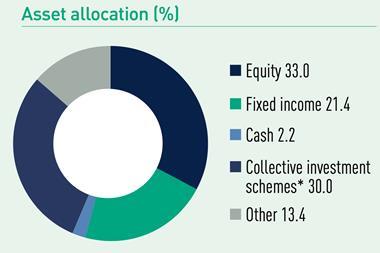With the call for evidence around how defined benefit (DB) schemes can increase their investments in start-ups, infrastructure, private and illiquid assets closing today, consultants have called for trustees to break their focus from de-risking.
On 10 July, the UK chancellor of the exchequer Jeremy Hunt announced a package of proposed financial service reforms of which nine related to pensions.
This included a call for evidence around how DB schemes can invest ‘more flexibly’, and more specifically, increase their investment equity capital and finance UK companies including start-ups, infrastructure, private equity and illiquid assets.
Industry consultants have shared what needs to be done to encourage DB schemes to take on more investment risk, as widespread concern across the government and the pension industry of nearly £1.5trn of DB assets are not being invested as productively as it could be.
But after a decade of regulatory pressure to de-risk and move towards an ‘end game’ of buyout with an insurer, LCP argued that it will take “more than words of encouragement” from the government to get schemes to take a different approach.
LCP highlighted two main barriers to large, well-funded schemes being willing to take on more investment risk and invest for the long term in productive finance. This is because trustees are focused on getting members’ benefits paid and sponsors see little advantage in targeting higher returns.
To overcome these barriers, LCP has proposed a two-part package solution, adding that these ideas have been discussed with government ministers, civil servants and regulators over the last 12 months.
One of the changes proposed by LCP calls for the introduction of a new opt-in regime for sponsors of well-funded schemes which would provide full protection for member benefits through the Pension Protection Fund (PPF). This would require DB schemes to pay an additional PPF ‘superlevy’ which would ensure 100% of member benefits were protected in the event of sponsor insolvency.
According to LCP, knowing that member benefits are fully underwritten by the PPF will encourage trustees to explore taking on more investment risk.
When it comes to the separate proposal by the Tony Blair Institute for up to 4,500 DB schemes to be consolidated into the PPF, with all assets and administration being moved across, LCP pointed out that this would be a massive undertaking, with the PPF having to carry out individual assessments of each scheme and understand the unique benefit structures and rules of each, as well as undertaking a data cleanse before a scheme transfer.
A focus on smaller schemes could also mean that a huge amount of effort is expended on consolidating large numbers of small schemes with little impact on the overall amount of productive investment, according to LCP.
The firm’s consultation response stated that the smallest 2,000 DB schemes currently have assets of under £20bn between them whereas a single large DB scheme can have more assets than this.

Jonathan Camfield, partner at LCP, said: “There is widespread agreement that DB pension fund assets could be invested more productively. But trustees have little incentive to agree to any form of re-risking if this puts member benefits at greater risk.
“In our view the ‘secret sauce’ which would unlock this barrier would be the creation of a new PPF regime allowing sponsors to opt into 100% protection of member benefits. Only with this security will trustees be more willing to take a fresh look at scheme investment strategy.”
Camfield added that these regulatory changes will enable a “step change” in pension scheme productive finance that he believes has the potential to be worth £100bn to the UK economy.
He said that while other ideas for a DB reform have been proposed, they involve a huge amount of time and effort in moving the assets of smaller pension schemes into a central consolidator like the PPF, despite most DB assets not sitting in small pension schemes.
He said: “If the government is serious about getting DB assets more productively invested now, it should start with the biggest and best-funded schemes, and should enable the assets to be more productively invested where they are, rather than be distracted by moving around the assets of the smallest schemes.”
Steward Hastie, partner at Isio, agreed that the main reason that DB schemes have been investing more cautiously is 30 years of regulation driving them down that path.
He said: “Sponsors have diverted cash to fund this de-risking, resulting in much more protection for pension scheme members.
“We may be too far down the road to unwind this, but steps could be taken to put the brakes on.”
Hastie added that to incentivise DB schemes to remain open or to delay transferring to an insurer, overriding legislation is needed that “resets the balance”, pointing out that trustees should have incentives to take modest levels of risk “not as little as possible”.
He continued: “For example if trustees’ duties were to include improving members’ benefits – with regular distributions of surplus being shared between members and the sponsor.
“While this would encourage schemes to run on and adopt slightly higher investment return targets, it is more likely this may encourage more use of illiquid debt rather than illiquid equity.”
Hastie also agreed that attempts by the government to appropriate the surplus in the PPF are “ill-founded”. He said: “The PPF is an industry-wide self-insurance vehicle which has never had a government guarantee. So it must be right that the benefits of surplus should pass back to the schemes and members that funded it.”
He added that if the government “genuinely” wants more investment in productive capital it has to think more about making this an attractive investment rather than “twisting the arms of DB pension schemes”.
He said: “The government may find it would be better focusing on insurance companies, as this is where most of pension industry consolidation is happening.”
Cart before the horse
But according to Patrick Bloomfield, partner and senior actuary at Hymans Robertson, the focus on boosting DB investment in UK productive finance assets feels like “putting the cart before the horse”.
He said: “What we need are policies that create a DB renaissance, to align DB schemes with wider social interests, by extending time horizons and increasing risk appetites.”
This, according to Bloomfield, would lead to the investment in productive assets and higher savings rates than the government desires.
He added that a “rebirth” of DB would be best achieved by updating DB’s statutory objectives to balance security of accrued rights with the current and future pension provisions. He said this would pave the way for “meaningful and lasting” DB investment in productive finance, rather than a “faddish policy flash-in-the-pan”.
Canadian, Nordic and Dutch examples
Cardano, meanwhile, argued that examples of successful investment in productive assets by Canadian, Nordic and Dutch pension funds offer the “most obvious” route to unlocking funds to underpin UK economic growth.
It said that UK public and state pension schemes would also reduce the long-term fiscal burden on the state and avoid the constraints that would necessarily apply to reforming corporate DB pensions in order to protect member benefits.
It therefore proposed the creation of a public or state pension fund with similar investment strategies to its global peers.
The firm highlighted four arguments in favour of the reform:
- State and public pensions are open by definition and only mature with the population. As a result, they can be truly long-term in perspective and natural providers of capital for long-term investments;
- They form naturally consolidated large pools of capital – for example, PFZW provides pensions to three million Dutch public employees in the care and welfare sector and has over €200bn in assets. A UK equivalent would be significantly larger if fully funded;
- There is no need to significantly change the existing regulatory and legal framework – as well as successful examples overseas, the UK’s Local Government Pension Scheme provides an established domestic model to build on;
- It would be much easier for government to mandate a minimum exposure to UK productive assets for a state or public pension fund rather than corporate funds.

Kerrin Rosenberg, chief executive officer of Cardano Investment, said: “For a long time the UK’s DB pension regime has worked incredibly effectively to prioritise delivering members’ benefits, often at the expense of the sponsoring employer and the wider economy.
“Policymakers’ appetite to stimulate the economy and encourage investment in UK productive assets is laudable. However, with the majority of DB schemes closed and on an inexorable path to de-risking, there are more obvious solutions available that don’t involve ripping up the regulatory rulebook.”
Rosenberg said that by harnessing the “vast” potential of unfunded state and public service pensions, “we can act now to support economic growth over the next decade and beyond, while also safeguarding state pension benefits for future generations”.
He noted that a public and state pension superfund could become a significant contributor to UK economic growth, while also freeing up funds from national insurance contributions to support state spending commitments in other socially important areas.
Read the digital edition of IPE’s latest magazine


































No comments yet